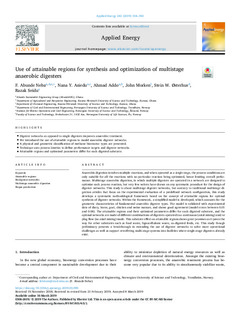| dc.contributor.author | Neba, Fabrice Abunde | |
| dc.contributor.author | Asiedu, Nana Yaw | |
| dc.contributor.author | Addo, Ahmad | |
| dc.contributor.author | Morken, John | |
| dc.contributor.author | Østerhus, Stein Wold | |
| dc.contributor.author | Seidu, Razak | |
| dc.date.accessioned | 2020-02-06T08:06:42Z | |
| dc.date.available | 2020-02-06T08:06:42Z | |
| dc.date.created | 2019-03-16T11:34:43Z | |
| dc.date.issued | 2019 | |
| dc.identifier.citation | Applied Energy. 2019, 242 334-350. | nb_NO |
| dc.identifier.issn | 0306-2619 | |
| dc.identifier.uri | http://hdl.handle.net/11250/2639929 | |
| dc.description.abstract | Anaerobic digestion involves multiple reactions, and when operated as a single stage, the process conditions are only suitable for all the reactions with no particular reaction being optimized, hence limiting overall performance. Multistage anaerobic digestion, in which multiple digesters are operated in a network are designed to optimize each process reaction, but very few writers have drawn on any systematic procedure for the design of digester networks. This study is about multistage digester networks, but contrary to traditional multistage digestion articles that focus on the experimental evaluation of a predefined network configuration, this study develops a systematic methodological framework based on the concept of attainable regions for optimal synthesis of digester networks. Within the framework, a simplified model is developed, which accounts for the geometric characteristics of fundamental anaerobic digester types. The model is validated with experimental data of diary, horse, goat, chicken and swine manure, and shows good agreement (model errors between 0.01 and 0.06). The attainable regions and their optimized parameters differ for each digested substrate, and the optimal networks are made of different combinations of digesters operated in a continuous (axial mixing) and/or plug flow (no axial mixing) mode. This substrate effect on attainable regions shows great promises as it paves the way for other substrates such as food waste, lignocellulosic waste, co-digested feeds, etc. This study though preliminary presents a breakthrough in extending the use of digester networks to solve more operational challenges as well as support retrofitting multi-stage systems into facilities where single-stage digesters already exist. | nb_NO |
| dc.language.iso | eng | nb_NO |
| dc.publisher | Elsevier | nb_NO |
| dc.rights | Attribution-NonCommercial-NoDerivatives 4.0 Internasjonal | * |
| dc.rights.uri | http://creativecommons.org/licenses/by-nc-nd/4.0/deed.no | * |
| dc.title | Use of attainable regions for synthesis and optimization of multistage anaerobic digesters | nb_NO |
| dc.type | Journal article | nb_NO |
| dc.type | Peer reviewed | nb_NO |
| dc.description.version | publishedVersion | nb_NO |
| dc.source.pagenumber | 334-350 | nb_NO |
| dc.source.volume | 242 | nb_NO |
| dc.source.journal | Applied Energy | nb_NO |
| dc.identifier.doi | 10.1016/j.apenergy.2019.03.095 | |
| dc.identifier.cristin | 1685294 | |
| dc.description.localcode | (C) 2019 The Authors. Published by Elsevier Ltd. This is an open access article under the CC BY-NC-ND license (http://creativecommons.org/licenses/BY-NC-ND/4.0/). | nb_NO |
| cristin.unitcode | 194,64,93,0 | |
| cristin.unitcode | 194,64,91,0 | |
| cristin.unitname | Institutt for havromsoperasjoner og byggteknikk | |
| cristin.unitname | Institutt for bygg- og miljøteknikk | |
| cristin.ispublished | true | |
| cristin.fulltext | original | |
| cristin.qualitycode | 1 | |

